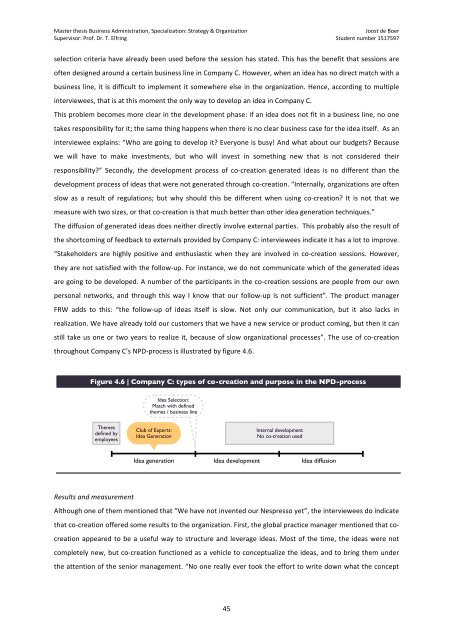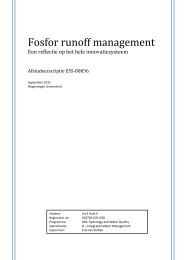Download PDF (English) - Future Ideas
Download PDF (English) - Future Ideas
Download PDF (English) - Future Ideas
You also want an ePaper? Increase the reach of your titles
YUMPU automatically turns print PDFs into web optimized ePapers that Google loves.
Master thesis Business Administration, Specialization: Strategy & Organization <br />
Supervisor: Prof. Dr. T. Elfring <br />
Joost de Boer <br />
Student number 1517597 <br />
selection criteria have already been used before the session has stated. This has the benefit that sessions are <br />
often designed around a certain business line in Company C. However, when an idea has no direct match with a <br />
business line, it is difficult to implement it somewhere else in the organization. Hence, according to multiple <br />
interviewees, that is at this moment the only way to develop an idea in Company C. <br />
This problem becomes more clear in the development phase: if an idea does not fit in a business line, no one <br />
takes responsibility for it; the same thing happens when there is no clear business case for the idea itself. As an <br />
interviewee explains: “Who are going to develop it? Everyone is busy! And what about our budgets? Because <br />
we will have to make investments, but who will invest in something new that is not considered their <br />
responsibility?” Secondly, the development process of co-‐creation generated ideas is no different than the <br />
development process of ideas that were not generated through co-‐creation. “Internally, organizations are often <br />
slow as a result of regulations; but why should this be different when using co-‐creation? It is not that we <br />
measure with two sizes, or that co-‐creation is that much better than other idea generation techniques.” <br />
The diffusion of generated ideas does neither directly involve external parties. This probably also the result of <br />
the shortcoming of feedback to externals provided by Company C: interviewees indicate it has a lot to improve. <br />
“Stakeholders are highly positive and enthusiastic when they are involved in co-‐creation sessions. However, <br />
they are not satisfied with the follow-‐up. For instance, we do not communicate which of the generated ideas <br />
are going to be developed. A number of the participants in the co-‐creation sessions are people from our own <br />
personal networks, and through this way I know that our follow-‐up is not sufficient”. The product manager <br />
FRW adds to this: “the follow-‐up of ideas itself is slow. Not only our communication, but it also lacks in <br />
realization. We have already told our customers that we have a new service or product coming, but then it can <br />
still take us one or two years to realize it, because of slow organizational processes”. The use of co-‐creation <br />
throughout Company C’s NPD-‐process is illustrated by figure 4.6. <br />
Figure 4.6 | Company C: types of co-creation and purpose in the NPD-process<br />
Idea Selection:<br />
Match with defined<br />
themes / business line<br />
Themes<br />
defined by<br />
employees<br />
Club of Experts:<br />
Idea Generation<br />
Internal development<br />
No co-creation used<br />
Idea generation Idea development Idea diffusion<br />
Results and measurement <br />
Although one of them mentioned that “We have not invented our Nespresso yet”, the interviewees do indicate <br />
that co-‐creation offered some results to the organization. First, the global practice manager mentioned that co-creation<br />
appeared to be a useful way to structure and leverage ideas. Most of the time, the ideas were not <br />
completely new, but co-‐creation functioned as a vehicle to conceptualize the ideas, and to bring them under <br />
the attention of the senior management. “No one really ever took the effort to write down what the concept <br />
45





